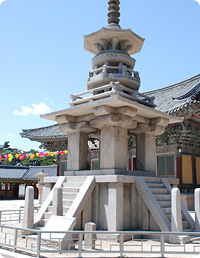UNESCO Heritages
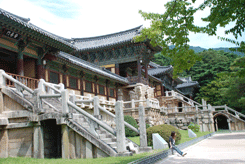 |
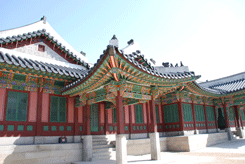 |
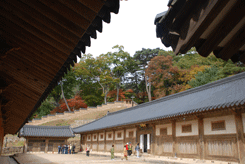 |
Seokguram Grotto and Bulguksa Temple / Baekje Historic Areas / Changdeokgung Palace Complex / The Depositories for the Tripitaka Koreana Woodblocks / Gochang, Hwasun and Ganghwa Dolmen Sites / Gyeongju Historic Areas / Historic Villages of Korea Hahoe and Yangdong / Jeju Volcanic Island and Lava Tubes / Jongmyo Shrine / Royal Tombs of the Joseon Dynasty / Sansa, Buddhist Mountain Monasteries / Seowon, Korean Neo-Confucian Academies / Hwaseong Fortress / Namhansanseong / The tidal flsts / Gaya Tumuli
Changdeokgung Palace Complex
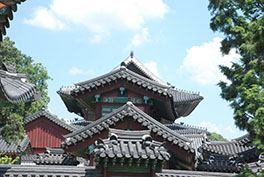 Changdeokgung Palace.
Changdeokgung Palace.
The palace is divided into two parts: the main building and the secret garden.
It is a detached palace built in 1405. In 1592 the Changdeok palace complex was completely burnt down except for the main gate Donhwamun, which naturally became the oldest surviving structure of the palace by the Japanese invasion under Hideyoshi's leadership. The palace was rebuilt in 1610 with more color and with a slightly different style of architecture. From this date, 13 kings used it as their official residence, except for a limited period of time when the Gyeongbok palace was restored and used by King Gojong. Renovated in 1907, Changdeok palace was used by Sunjong until his death in 1926.
The palace is divided into four major areas; Central palace buildings, Secret garden, Nakseonje and Seonwonjeon. Among the other attractions are private royal residences of Huijongdang, Taejojeon, the royal infirmary, Nakseonje, the residence of the widow of King Yeongchin (1897-1970) who was the last crown price, and Biwon or secret garden. Injeongjeon is a large double-roofed audience hall, the highest within the palace compound. It is surrounded by covered corridors which lead into adjoining reception rooms. In front of the hall, 12 tablets are positioned on each side of the raised walkway, denoting the various ranks of government officials. The steps leading to the double-tiered platform are flanked with crouching stone Haetae which continues to protect this building from fire. On the roof ridges solemnly sit eight rows of clay figurines called Japsang, which guard eternally against dangers to this magnificent structure. The first image represents a sitting man, Samjangbeopsa, a priest of early China who was later deified. A monkey, pig, snake and other creatures are further back.
The throne chair is in the middle of the hall. Behind the throne seat is a large Sun Moon screen with five mountains which depicts the adopted Confucian symbolism. Five happiness or five elements of wood, fire, earth, metal and water. Originally the structure was painted predominantly in red and green, the colors used by kings, but in the year that King Kojong declared Korea's independence from China the color scheme was changed to yellow, the imperial color the Emperor of Heaven. The hall itself has a high elegantly painted and gilded ceiling supported by numerous great red pillars. The entire courtyard is covered with flagstones. East of the main throne hall is the small audience chamber, Seonjeongjeon, the hall of the Dissemination of Government once used for receiving civil and military officials, and later foreign dignitaries. Reconstructed in 1653, it is the only building now roofed with blue glazed tiles.
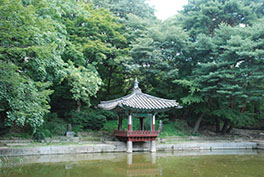 Secret Garden
Secret Garden
Behind the Changdeok palace is the Secret Garden covering 316,00㎡ of ground. It includes 44 buildings in different size as well as several ponds, springs, and streams. The garden was laid out in 1405 and enlarged in 1623. Throughout the year seasonal changes are mirrored in the placid ponds, while the fanciful pavilions continue to fascinate the young and the old. Buyongjeong is a graceful pavilion set by the large lotus pond, Buyongji, which is said to be fed by four springs but today these springs cannot be found. This pond has a small islet, and on the west of the pond is a small tablet constructed by Sukjong (the 19th king of the Joseon Dynasty) tells of the discovery of these four springs. Opposite the lotus pond is the Osumun gate and the Juhapru pavilion. The architectural design of this gate is impressive since the heavy roof is supported only by two small pillars. Juhapru is a double storey building built by Yeongjo (the 21st king of the Joseon Dynasty). The lower floor was used as a royal library while the top floor, overlooking the spacious gardens and lotus pond spattered with colorful tints of blossoms, provided a place for entertainment and feasts. Yeonghwadang, the Lotus flower-reflecting pavilion is located east of the first lotus pond upon entering the Secret Garden. It was built in 1692 and was used for public examinations for positions as government officials.
On the southwestern corner of the building displays a sundial. Yeongyeongdang is the maximum size under the Joseon dynasty laws, which forbade anyone other than royalty to have a house of more than 100 Kan. Built in 1828, it is the only house in the palace in the style of a private residence, where Sunjo often frequented to experience the private life. The king sometimes visited here to experience private life. At those times every aspect of his lifestyle followed that a man of noble birth, right down to the clothing he wore. This house is a good example of a nobleman's of and is thus a precious historical resource. Upon entering Yeongyeongdang, the visitor encounters a wide yard and the servants' quarters. After entering the Jangnakmun, a high gate in the wall, on either side are two inner gates. The men's quarters lie through the gate Jangyangmun to the right, while the women's quarters lie through the Suinmun gate to the left. There is a low wall between the quarters for men and women, and thus they appear to be two separate buildings. But, they are actually connected as one. To the east of men's quarters is an inner gate that passes through the servants' quarters, and behind the women's quarters is the separate kitchen. The stonework, channels, and ponds outside Jangnakmun, and the terraced flower beds of Nongsujeong all exhibit the style of a nobleman's garden of the days. The palace can be visited individually, but the Secret Garden is in group at designated time. English guided tour is available at 11:30, and 14:30 daily except Monday.
Jongmyo Shrine
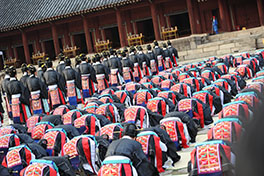 It is located in south of the Changgyeong palace in Seoul. Being the premier ancestral shrine in Korea, it is dedicated to the spirits of Korea's royal ancestors. It was built by the founder of the Joseon dynasty in 1396 and has been extended ever since. Today ancestral ritual service is performed here by the Yi families every first Sunday of May. The ritual is usually from 09:30 to 14:30 accompanied by royal procession from the palace to the shrine as it used to. The Jongmyo ceremony pays reverence to the spirits of 20 Joseon dynasty kings and queens with music and dance. Jongmyo Jerye, or the Royal Ancestral Rite was one of the most important court events during the Joseon period. It was conducted five times annually. Joseon kings and court dignitaries made an imposing spectacle officiating before the 20 individual shrines. The special music, composed by King Sejong, using the same jade-stone gongs with gradual thickness, bells and other traditional musical instruments, has a richer texture than the Confucian rites. It is closed on Tuesdays.
It is located in south of the Changgyeong palace in Seoul. Being the premier ancestral shrine in Korea, it is dedicated to the spirits of Korea's royal ancestors. It was built by the founder of the Joseon dynasty in 1396 and has been extended ever since. Today ancestral ritual service is performed here by the Yi families every first Sunday of May. The ritual is usually from 09:30 to 14:30 accompanied by royal procession from the palace to the shrine as it used to. The Jongmyo ceremony pays reverence to the spirits of 20 Joseon dynasty kings and queens with music and dance. Jongmyo Jerye, or the Royal Ancestral Rite was one of the most important court events during the Joseon period. It was conducted five times annually. Joseon kings and court dignitaries made an imposing spectacle officiating before the 20 individual shrines. The special music, composed by King Sejong, using the same jade-stone gongs with gradual thickness, bells and other traditional musical instruments, has a richer texture than the Confucian rites. It is closed on Tuesdays.
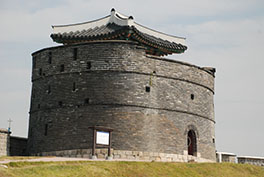 Hwaseong Fortress
Hwaseong Fortress
Suwon Hwaseong was built in 1794-1796 during the reign of King Jeongjo, the 22nd ruler of the Joseon dynasty (1392-1910). Embracing the busy downtown area of the Suwon, some 30km south of Seoul, Hwaseong Fortress embodies Jeongjo's devotion to his ill-fated father and his ideals for a modern administrative and commercial center with stalwart defense. The 5.74Km wall, fortified with various military facilities, is the shining accomplishment of a sagacious king who led a political and cultural renaissance with the counsel of young scholars seeking institutional reforms and practical application of academic theories. Though it is relatively small in scale, Suwon Hwaseong has been recognized by experts as the best structure of its kind built ever built. The fortress has a total perimeter of 5.74Km and encloses an area of 1.3㎢. The four major gates stand in the four cardinal directions: Janganmun in the north, Paldalmun in the South, Changnyongmun in the east and Hwaseomun in the west. The two larger gates, Janganmun and Paldalmun, have an imposing two-storey wooden pavilion standing on top of a stone structure with an arched entrance, which is shielded by a semicircular chemise built of brick and flanked by gate guard platforms on either side. The chemise also has an arched entrance in the center and a single-storey pavilion-shaped wooden superstructure. The chemise is connected to the gate guard platforms with parapet walks with crenels and merlons. There are five machicolations over the arched entrance.
The fortress has multifunctional design as a military, political, and commercial center, making it very unique indeed. The fortress is parapeted with crenels and merlons and highlighted by lofty watch towers and secret gates leading down to dark labyrinths. Hwaseong Fortress stretches over changing terrain from high mountain ridges overlooking a crowded urban center to flat land park with well-tended lawn to a bustling marketplace surrounded by a densely populated neighborhood. The stone rampart, roughly an oval shape extending to north and south but meandering due to the changing topography, is some 4-6 meters in height, growing higher on flatland and lower on mountain ridges. In most sections, the ground level is much higher inside the rampart than outside, a plan to make it difficult for enemy troops to approach. The fortress looks remarkably different from most other ancient town walls and military fortifications scattered around Korea. It stands out not only for its diverse functions but the aesthetic novelty and technical innovation involved in its planning and construction.
Walking counterclockwise to the west from this gate, the first structure encountered across the traffic road is a gate guard platform, which rises higher than the rampart. About 1km from here past a park with well-tended lawn are two sentry towers that are pavilion-like buildings standing on protruding battlements. Hwaseomun, the west gate with a single-storey wooden superstructure, looks smaller and simpler than Janganmun and Paldalmun. But an observation tower standing nearby is worthy of attention for its unique appearance.
The fortress originally had three observation towers named Gongsimdon, meaning "tower with empty interior," one to the northwest, one to the south and one to the northeast. The southern tower was removed as Suwon expanded in modern times. The two remaining towers are among the most distinctive structures among all facilities of the fortress. Built of stone and brick and topped by a pavilion-type wooden superstructure, the three-storey towers have gun embrasures arranged alternately to serve the purposes of observing enemy movements and firing arms. They have wooden floor, spiral ladders and banquettes on the wall inside. The southwestern stretch of the fortress, from Hwaseomun to Paldalmun, meanders along the ridges of Mt. Paldalsan overlooking lush wood and beyond to downtown Suwon. Among the structures here are two corner towers, three sentry towers, a command post, an arrow launching platform and two secret gates.
From here past Paldalmun and market and then across a stream, the rampart runs to another corner tower, more sentry towers and beacon tower. The brick-built beacon tower has five mounds for making different signals with fire or smoke: one for peace time; two when the enemy has been spotted; three when the enemy is approaching; four when the enemy has made its way into the city; and five when combat has stared. Past another sentry tower from here is the east gate named Changnyongmun and an arrow-launching platform. The northeastern observation tower looms high over the rampart.
The eastern command post stands nearby, which is connected to a secret gate, then past another sentry tower and another secret gate, there is the most beautiful section of the fortress, surrounded by a picturesque landscape. The northeastern corner tower is an exquisite L-shaped pavilion with an ornate roof, which stands on a hill with beautiful willow trees overlooking a lotus pond with an artificial islet. Not far from this pavilion is located the northern floodgate, a stone bridge with seven arched sluices topped by an elegant open pavilion and brick-built parapet.
Hwaseong Haenggung Palace is the largest of the Joseon temporary palaces, and situated nearly in the center of the fortress, and in the shadow of Paldalsan. At its height, the palace included 576 compartments that featured feasts and cultural performances. It was the hope of King Jeongjo to move the seat of power from Seoul to Hwaseong during his reign, an event that never fully manifested. Entrance to the Haenggung is granted by passing through Sinpungmun. The gateway means new hometown and further reflects the king’s desire to settle here. Initial construction began in 1789, but was expanded during the fortress’ creation between 1794 and 1796.
The compound included twenty-two buildings at its completion, not including servants’ quarters.
The Hwaseong Haenggung isn’t as lavish as the Grand Palaces of Seoul, and probably leading to some of its charm. It literally is a retreat and walking the grounds gives visitors that sense. Many who take the time to visit the detached palace do so in a leisurely manner. While several tours are available, and it’s quite popular with local schools, many guests take the opportunity to relax in open rooms and pavilions. It’s something that can’t be done in Seoul, and a welcome change. Visitors can play traditional games, make rice cakes, or even choose to experience being trapped in a rice chest as King Jeongjo’s father (Crown Prince Sado) was ? which ultimately lead to the creation of this location.
During the annual Suwon Cultural Festival, extra events take place on these historic grounds, like the civil service exam and King Jeongjo’s Procession. Constructed in 1801 was the Hwaryeongjeon, a small complex built to house the portraits of King Jeongjo. He was never able to see its completion, so it was finally erected during the first year of King Sunjo’s reign. Other such buildings typically retain ancestral tablets, but that is not the case here. Housing royal portraits is an act usually reserved for living monarchy and is something of a rarity in Korea.
Here, 48 structures in anti-clockwise order beginning by the South Gate.
Paldalmun, South Gate (팔달문)
South-East Gate Guard Platform (남동적대)
South Secret Gate (남암문)
South-East Observation Tower (동남공심돈)
Namsumun (남수문)
South-East Pavilion (동남각루)
East Turret 3 (동삼치)
East Sentry Post 2 (동이포루)
Beacon Tower (봉돈)
East Turret 2 (동이치)
East GunTower (동포루)
East Turret 1 (동일치)
East Sentry Post 1 (동일포루)
Changryongmun, East Gate (창룡문)
North-East Crossbow Platform (동북노대)
North-East Observation Tower (동북공심돈)
East Command Post (동장대)
East Secret Gate (동암문)
East-North Sentry Post (동북포루)
North Secret Gate (북암문)
North-East Pavilion (동북각루)
Hwahongmun (화홍문)
North-East GunTower (북동포루)
North-East Turret (북동치)
North-East Gate Guard Platform (북동적대)
Janganmun, North Gate (장안문)
North-West Gate Guard Platform (북서적대)
North-West GunTower (북서포루)
North Sentry Post (북포루)
North-West Observation Tower (서북공심돈)
Hwaseomun, West Gate (화서문)
North-West Pavilion (서북각루)
West Turret 1 (서일치)
West GunTower (서포루)
West Turret 2 (서이치)
West Crossbow Platform (서노대)
West Command Post (서장대)
West Secret Gate (서암문)
West Sentry Post (서포루)
West Turret 3 (서삼치)
South-West Secret Gate (서남암문)
South-West Spur (용도)
South-West Turret 1 (용도서치)
South-West Pavilion (서남각루)
South-West Turret 2 (용도동치)
South GunTower (남포루)
South Turret (남치)
South-West Gate Guard Platform (남서적대)
Seokguram Grotto and Bulguksa Temple
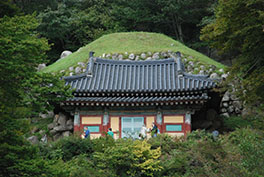 Seokgram
Seokgram
Located in Gyeongju, the temple construction began in 751 by Kim Daeseong who had two parents and was completed in 774. He lived poor with a widowed mother. One day they offered a small donation to the Buddha and the temple. Upon his sudden death, he was reincarnated in the Kim Munryang's family. One day he was strongly inspired by the Buddhism and finally decided to build beautiful temples for his two parents. Bulguksa is the one for his present parents and Seokguram is for the former parents. The man-made cave houses one of the most beautiful Buddha statues in the world. High up on the Tohamsan Mountain, behind the Bulguksa temple, this 9m high domed rotunda, which was built to represent the Buddhist world, also contains thirty nine Bodhesattvas, the Buddha Sakyamuni's ten enlightened disciples, gods and guardians. During the Joseon dynasty when Buddhism was persecuted, this national masterpiece was forgotten. Then, one cloudy day in 1909, a lone postman suddenly had to take a shelter from a thunderstorm. He dashed to the dim light, and saw the magnificent statue. After its rediscovery, the Seokguram grotto was opened to the public, and become a well- known attraction. A traditional-style building erected over the cave's entrance creates a darkened area from which to view the serene and graceful lines of the big Buddha statue (3.48m high) inside. Thus, even though one has to look through protective glass, there are none of the reflections that formerly impaired viewing. Inside the cave, the statue is well lit giving a fine view of the remarkable and delicate stone carving that is dated to 751.
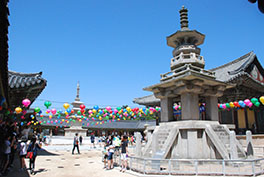 Bulguksa
Bulguksa
Located in Gyeongju, the temple was built in 774. It is one of the best known and oldest temples in Korea. The name means 'Buddha Land' and it is located on the outskirts of Gyeongju, the ancient capital of the Unified Silla Kingdom. The temple was first built in 535 during the reign of King Beopheung (reign: 514-540), the first Silla king to accept Buddhism. In 751, the temple was expanded during the reign of King Gyeongdeok (reign: 752-765) by minister Kim Daeseong in honor of his parents. He also built the Seokguram grotto in memory of the poor parents of his previous life. The Bulguksa temple epitomizes the spirit of Silla, bearing witness to the architectural achievements of the period and showing highly refined aesthetic beauty.
Two mortarless stone pagodas stand complementing each other in the courtyard of the temple. Seokgatap Pagoda (8.2m high) is representative of the trend during the Unified Silla period when pagodas were simplified to consist of three stories. The simplicity of this pagoda is enhanced by the complexity of its twin Dabotap Pagoda (10.4m high). Seokgatap remained relatively well-preserved until it was vandalized by a robber in September 1966. In October of that year, disassembly began on the pagoda's main body, with reconstruction completed in December 1966. It is the first full disassembly since the construction of the 8.2m pagoda in 751. In this process, a variety of sacred objects including a sari were found within the two-story body as well as the Mugujeonggwang Great Dharani Sutra, 6.2m long and 6.7cm wide, a famous Buddhist scripture that has been recognized as the world's oldest woodblock printed document. Having started in September 2012, the pagoda restoration project was completed in December, 2015. Constructed along with Seokgatap, Dabotap has a markedly different structure from the typical Silla pagoda format of a two-story base and a three-story pagoda body, and is evaluated as the best example of the heteromorphic pagoda. The steps are believed to have each had their own railing, with four lions at the corners of the flat stones at the top of each flight of steps. However, during the disassembly and renovation work done by the Japanese colonial government in 1925, the sari and artifacts inside the pagoda body as well as three of the lions disappeared. One lion figure is currently housed at the British Museum in London, while the whereabouts of two other lions are still unknown. There is currently only one lion figure remaining at Dabotap.
Legend tells that they were both created by a mason called Asadal who left his young wife Asanyeo, promising to return as soon as the pagodas were completed. After years of waiting, Asanyeo journeyed to Gyeongju but was prohibited from visiting the pagodas. She was told to wait near a pond and that she would know when the pagodas were completed as they would reflect in the pond. Eventually, out of desperation, she threw herself into the pond. Thus, Seokgatap Pagoda is sometimes called the 'Pagoda without Reflection'.
The Bulguksa temple is particularly famous for its graceful staircases, actually bridges that lead from the secular world to the Land of the Buddha. The one to the east is called Blue and White Cloud Bridge. The second bridge stairway, to the west, is called the Lotus Flower and the Seven Gems. There are two 9th century gold leaf statues, one of Amitabha, the Buddha of Light and the other of Virocana, the Buddha of Cosmic Power. They are considered to be the oldest and largest sitting gold statue in Korea. The Amitabha statue is in the Paradise Hall which is connected the Virocana Hall by a covered corridor.
Gyeongju Historic Areas
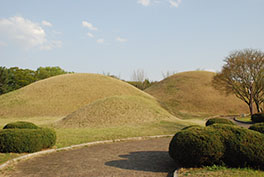 The Gyeongju Historic Areas covers Mount Namsan belt, Wolseong belt, the tumuli park belt and Hwangryeongsa. The areas contain a remarkable concentration of outstanding examples of Korean Buddhist art, in the form of sculptures, reliefs, pagodas, and the remains of temples and palaces from the flowering of this form of unique artistic expression. Gyeongju City and its surroundings have inherited traces of the glory that flowered and withered in the ancient Silla Kingdom (BC 57 - AD 935). The Mount Namsan Belt, which lies to the north of Gyeongju City. Before the arrival of Buddhism in the early Silla period, Mount Namsan in Gyeongju City was worshipped as one of the five sacred mountains. It was the seat of a refined form of shamanism with elements of native cults, fetishism, and animism. With the spread of Buddhism it became the earthly representation of Sumeru, the heavenly mountain of the Buddhist lands. Its gorges and ridges are embellished with granite pagodas, filigree works, pottery buried in the earth for more than a thousand years, impressive royal graves and palace sites, and stone sculptures and rock-cut reliefs of Buddha.
The Gyeongju Historic Areas covers Mount Namsan belt, Wolseong belt, the tumuli park belt and Hwangryeongsa. The areas contain a remarkable concentration of outstanding examples of Korean Buddhist art, in the form of sculptures, reliefs, pagodas, and the remains of temples and palaces from the flowering of this form of unique artistic expression. Gyeongju City and its surroundings have inherited traces of the glory that flowered and withered in the ancient Silla Kingdom (BC 57 - AD 935). The Mount Namsan Belt, which lies to the north of Gyeongju City. Before the arrival of Buddhism in the early Silla period, Mount Namsan in Gyeongju City was worshipped as one of the five sacred mountains. It was the seat of a refined form of shamanism with elements of native cults, fetishism, and animism. With the spread of Buddhism it became the earthly representation of Sumeru, the heavenly mountain of the Buddhist lands. Its gorges and ridges are embellished with granite pagodas, filigree works, pottery buried in the earth for more than a thousand years, impressive royal graves and palace sites, and stone sculptures and rock-cut reliefs of Buddha.
It is a treasure house of thousands of relics that embody Buddhist benevolence and law. The Buddhist monuments that have been excavated up to the present include the ruins of 122 temples, 53 stone statues, 64 pagodas, and 16 stone lanterns. Excavations have also revealed the remains of the pre-Buddhist natural and animistic cults of the region. The nomination dossier contains descriptions of 36 individual monuments, 11 rock-cut reliefs or engravings, 9 stone images and heads, 3 pagodas, 7 royal tombs or tomb groups, 2 wells, one group of stone banner poles, the Namsan Mountain Fortress, the Poseokjeong Pavilion site, and the Seochulji Pond. The rock-cut reliefs and engravings and the stone images are fine examples of Silla Kingdom Buddhist art. They are artistic masterpieces which trace the evolution of this especially refined school of Buddhist art throughout its most prolific and innovatory period, in particular from the 7th to the 10th century. They depict for the most part Buddha, and also the saints and bodhisattvas associated with him. The most impressive is probably the Buddha Rock, a massive natural formation in the Tapgol Valley. It is located close to a three-storey pagoda, and its three walls are decorated with vivid depictions in bas-relief of Buddha in different incarnations, surrounded by his acolytes and disciples. The royal tombs, in the form of simple earthen mounds or tumuli, reinforced by layers of stone slabs, are those of Silla kings from the 2nd to 10th century. There can be little doubt that many others remain to be found on the mountain, which was the preferred burial area for the Silla rulers. The Poseokjeong (Abalone) Pavilion takes its name from a shell-shaped stone watercourse within the enceinte. This is, in fact, the only element of the detached palace group that survives. It was the favored site of the Silla Kings for recreation and relaxation; one of the last members of the dynasty, Gyeongae, was murdered here by the founder of the succeeding Baekje Kingdom, Gyeonhwin, during a party here in 927.
Mount Namsan was first fortified in 591 and greatly enlarged in the later 7th century. This is the structure, the remains of which survive today as the Namsan Mountain fortress. Much of the parapet of the massive ramparts has been demolished, but enough survives to indicate that it stood originally to a height of no more than 2m. A broken stone inscription records the fact that the construction workers undertook to rebuild the fortress if it collapsed within three years of building. The Wolseong Belt occupies south of city center, dominated by the ruined palace site of Wolseong, the Gyerim woodland which legend identifies as the birthplace of the founder of the Gyeongju Kim clan, Anapji Pond, on the site of the ruined Imhaejeon Palace, and the Cheomseongdae Observatory. Wolseong (Moon Palace) takes its name from the shape of its compound. To the south the Namcheon stream forms a natural defense, and ditches were dug round the other three sides to create a water-filled moat. A royal palace was built here and reconstructed over succeeding centuries by successive Silla Kings, for whom it was their main palace. Another palace was built at Imhaejeon in the second half of the 7th century. Its opulent garden was graced by a beautifully configured pond, with a sacred mountain in its centre. Both palace and pond were destroyed when the Silla rulers were ousted, but what remains of the pond have always been populated by wildfowl, from which it acquired its popular name, Anapji, the Pond of Geese and Ducks. The Cheomseongdae Observatory was built towards the middle of the 7th century. The platform consists of twelve rectangular slabs, which support a structure of 365 granite blocks arranged in thirty successive layers. The circumference of the base is 5.17m and the total height is 9.17m; the structure tapers towards the top to provide stability. Access is by means of a window at this level and there is an internal staircase. The astronomical ascription derives from the fact that the number of blocks is equivalent to the number of days of the year and the number of open courses to the twelve months of the year and the signs of the Zodiac.
The Tumuli Park Belt consists of three groups of Royal tombs. Most of the mounds are domed, but some take the form of a half-moon or a gourd. They contain double wooden coffins covered with gravel. One of the earlier tombs yielded a mural painting on birch bark of a winged horse. Hwangnyongsa Belt consists of two ruined temples, Hwangnyongsa and Bunhwangsa. Hwangnyongsa, built to the order of King Jinheung (540-76) was the largest temple ever built in Korea, covering some 72,500㎡. An 80m high nine-storey pagoda was added in 645. The entire complex was destroyed by Mongol invaders in 1238; it was never rebuilt, but was occupied by more than a hundred families, who were moved out in 1976. Excavations have shown that in its original form the temple had seven rectangular courtyards, each with three buildings and one pagoda. The massive pagoda on the Bunhwangsa was built in 634, using dressed stone blocks. Analysis of the stone debris suggests that it originally stood to a height of seven to nine stories. Following Buddhist tradition, a stone lion guarded each corner of the basal platform. There is a doorway in the centre of each of the four walls of the lowest storey with two sliding doors flanked by high-relief carvings of fierce warriors or kings.
The Depositories for the Tripitaka Koreana Woodblocks
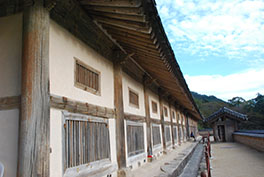 They are located on the slope of Gayasan national park, about 40Km west of Daegu. The excellent condition of the printing blocks of the Tripitaka Koreana, which have defied time and the elements over the last seven centuries, has emerged as a challenge to modern preservation science. The wood was meticulously processed for years to weatherproof and prevent decay, before and after the carving of the scriptures. But the manufacturing technology alone would not have been sufficient to preserve the numerous wooden blocks in such a perfect state over the centuries.
To a significant extent, the wonder is attributed to the wisdom of those who built the wooden depositories. Constructed in the late 15th century, about a century after the printing blocks were moved to Haeinsa, the two simple and sturdy structures, each of similar size and design, have perfectly played their intended role of preserving the priceless artifacts. The true challenge for modern architecture lies in the fact that the ancient builders took advantage of nature with prominent wisdom and technical knowhow in selecting the site and designing the buildings.
They are located on the slope of Gayasan national park, about 40Km west of Daegu. The excellent condition of the printing blocks of the Tripitaka Koreana, which have defied time and the elements over the last seven centuries, has emerged as a challenge to modern preservation science. The wood was meticulously processed for years to weatherproof and prevent decay, before and after the carving of the scriptures. But the manufacturing technology alone would not have been sufficient to preserve the numerous wooden blocks in such a perfect state over the centuries.
To a significant extent, the wonder is attributed to the wisdom of those who built the wooden depositories. Constructed in the late 15th century, about a century after the printing blocks were moved to Haeinsa, the two simple and sturdy structures, each of similar size and design, have perfectly played their intended role of preserving the priceless artifacts. The true challenge for modern architecture lies in the fact that the ancient builders took advantage of nature with prominent wisdom and technical knowhow in selecting the site and designing the buildings.
At the back of the main worship hall, a flight of steps leads up to a group of four depositories from the 15th century or Janggyeong Panjeon housing 81,258 wood-blocks of Tripitaka Koreana, an offering to the Buddha for national protection from the looming Mongol forces. The printing blocks are some 70cm wide, 24cm long and 2.8cm thick on the average. Each block has 23 lines of text, each with 14 characters, on each side. Each block thus has a total of 644 characters on both sides. Some 30 men carved the total of 52,382,960 characters in the clean and simple style. The characters are perfectly carved as if from the same hand. They were completed in 1251 after 16 years of work in Jeondeungsa temple on Ganghwado and were transported here for safekeeping. Two long depositories are designed to have natural ventilation by facing different size windows in the front and rear of the building.
The depositories stand at the highest level of the temple compound overlooking the beautiful roof lines of some thirty buildings including worship hall, dormitories and auditoriums. The two elongated structures with a rectangular courtyard in between stand at 655 meters above sea level, facing southwest. At this altitude and direction and being protected by high peaks at the back, the buildings can avoid both the damp southeasterly wind blowing up from the valleys and the cold northern wind, with no part of the structures affected by permanent shade.
Two small buildings standing on either end of the courtyard are storages of the printing blocks for scriptures and other books published by the temple.
Built upon low granite foundations, these wooden structures with hipped roofs, each measuring 60.44 meters long, 8.73 meters wide and 7.8 meters high, facilitate maximum ventilation as well as temperature and humidity control with no obvious devices other than open grill windows. The ingenuity of the ancient architects is shown in the layout of the windows. Both halls have two rows of wooden grill windows divided by a central molding on the front and back walls. In the case of the front hall, named Sudarajang, or the Hall of Sutras, the windows of the lower row in the front wall are about four times as large as those of the upper row, while the upper windows in the back wall are about one and a half times the size of the lower windows. In the case of the back hall, named Beopbojeon, or the Hall of Dharma, the lower windows on the front wall are approximately 4.6 times the size of the upper windows, and the upper windows on the back wall are about 1.5 times the size of the lower windows. This is apparently a plan based on the theory of hydrodynamics and air flow. The windows allow for maximum natural ventilation. Fresh air is brought in through the larger upper windows and moisture is prevented from seeping in from the ground from the back of the buildings as the lower windows are small. The fresh air is intended to circulate around the hall before escaping through the windows on the opposite side. Each hall has two lengthy rows of five-storey shelves.
Each storey contains two rows of woodblocks, vertically arranged one row upon the other. The printing blocks have thicker margins on the sides, so the carved sections are always exposed to the air flow.
The storage halls have clay floors to help control temperature and humidity. The floors have layers of salt, charcoal and lime underneath, which absorb excess humidity during the rainy season in the summer and maintain an optimum humidity level during the dry winter months. The roofs are built of clay and tiles over wooden rafters and simple brackets, which prevent abrupt changes in temperature caused by direct sunlight. All the natural and technical factors considered, it still remains a mystery how insects and wild animals are kept away from the buildings. The monks contend that not a single spider's web has been found within the halls and no mildew or moss either. Not a single bird has ever been seen resting on the roofs. The buildings survived fires that ravaged the temple no less than seven times, destroying all of its original structures.
In order to control the temperature and humidity within the depositories, there are restrictions to visitor entry into the Janggyeong Panjeon. In order to protect the Janggyeon Panjeon and woodblocks from fire, full-time security guards and a 24-hour surveillance system are in place. In addition, Cultural Heritage Administration of Korea decided to limit the public access to the whole Janggyeong Panjeon complex for 4 years from January 1, 2013 till December 31, 2016.
Gochang, Hwasun, and Ganghwa Dolmen Sites
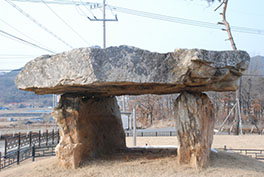 The prehistoric cemeteries at Gochang, Hwasun, and Ganghwa contain many hundreds of examples of dolmens, tombs from the 1st millennium BCE constructed of large stone slabs. They form part of the Megalithic culture, to be found in many parts of the world, but nowhere in such a concentrated form. Dolmens are megalithic funerary monuments, which are numerous in Asia, Europe, and North Africa. Korea has the greatest number of any country. These are of great archaeological value for the information that they provide about the prehistoric peoples who built them and their social and political systems, beliefs and rituals, arts and ceremonies, etc. The Gochang, Hwasun, and Ganghwa sites contain the highest density and greatest variety of dolmens in Korea, and indeed of any country. They also preserve important evidence of how the stones were quarried, transported, and raised and of how dolmen types changed over time in north-east Asia. Gochang Dolmen Sites located in the Jungnim-ri dolmens, is the largest and most diversified group, centre on the village of Maesan.
The prehistoric cemeteries at Gochang, Hwasun, and Ganghwa contain many hundreds of examples of dolmens, tombs from the 1st millennium BCE constructed of large stone slabs. They form part of the Megalithic culture, to be found in many parts of the world, but nowhere in such a concentrated form. Dolmens are megalithic funerary monuments, which are numerous in Asia, Europe, and North Africa. Korea has the greatest number of any country. These are of great archaeological value for the information that they provide about the prehistoric peoples who built them and their social and political systems, beliefs and rituals, arts and ceremonies, etc. The Gochang, Hwasun, and Ganghwa sites contain the highest density and greatest variety of dolmens in Korea, and indeed of any country. They also preserve important evidence of how the stones were quarried, transported, and raised and of how dolmen types changed over time in north-east Asia. Gochang Dolmen Sites located in the Jungnim-ri dolmens, is the largest and most diversified group, centre on the village of Maesan.
Most of them are located at altitudes of 15-50m along the southern foot of the hills running east-west. The capstones of the dolmens here are 1-5.8m in length and can weigh 10-300t. A total of 442 dolmens have been recorded, of various types, based on the shape of the capstone. Like those in the Gochang group, the Hwasun dolmens are located on the slopes of low ranges of hills, along the Jiseokgang river. Individual dolmens in this area are less intact than those in Gochang. The Hyosan-ri group is estimated to comprise 158 monuments and the Daesin-ri group 129. In a number of cases the stone outcrops from which the stones making up the dolmens were quarried can be identified. Ganghwa Dolmen Sites are on the offshore island of Ganghwa, once again on mountain slopes. They tend to be higher than those in the other sites and stylistically early, notably those at Bugun-ri and Gocheon-ri.
Jeju Volcanic Island and Lava Tubes
Hallasan
The high peak of Hallasan was formed by the volcanic activities during the last 200,000 years up to 3,000 years. Earlier, very viscous trachyte lava exuded to from the Baeknokdam crater. Afterwards, basaltic lave extruded from the east of Hallasan, producing a gentle frank there. The registered nature heritage consists of three main sites - Hallasan, the highest peak of the country, an extinct volcano topped by huge crater of which has a volcanic lake, called Baeknokdam (108m in length and 1,720 in circumference). Hallaan now rises in the center of the island to a height of 1,950m, with the rest of the island sloping down from its summit and covered with dark gray volcanic rocks and rich volcanic soil. Mt. Halla is a habitat for more than 1,800 plant species, almost half of over 4,000 species growing in Korea; it is in itself a virtual ecological park and botanical garden. Especially noteworthy are a variety of arctic-alpine plants including many endemic species and the forest of Korean fir (Abies koreana) on the slopes near the summit. The arctic-alpine plants inhabiting Mt. Halla include 33 species endemic to Jeju Island, one genus endemic to Korea, 56 species for which Jeju is their southern range limit, and three species for which the island is their northern range limit. These plants are valuable plant genetic resources of excellent research value. Seongsan Ilchulbong tuff cones, and Geomunoreum lava tube chain - that together make up 188.43㎢, 10.3% of the surface area of the Jeju Island. More than 120 lava tubes are scattered throughout Jeju Island.
Geomunoreum Lava System
While Mt. Halla and its 368 parasitic cones are volcanic landforms viewable above ground, lava tubes are the result of volcanic activities manifested below the ground.
One of the numerous parasitic cones distributed all over Jeju Island, Geomunoreum (465 meters above sea level) is located to the northeast of the island. The volcano erupted repeatedly between 300,000 and 100,000 years ago, and lava flows from these eruptions traveled down its northeastern slopes to the coastline, creating over 20 caves along their course. Collectively called the Geomunoreum Lava Tube System, this site retains traces that show how these massive lava tubes were formed and evolved into their current state. The lava tube system consists of 20 or more lava tubes of various lengths, structures and components. Geomunoreum Lava Tube System refers to a series of lava tubes formed in the large amounts of basaltic lava spewed out by the live Geomunoreum volcano. This volcano is located across two administrative areas (Deokcheon-ri, Gujwa-eup and Seonheul-ri, Jocheoneup) in Bukjeju-gun, Jeju-do. It is perched atop an elevation of 456.6 m.
The lava from the Geomunoreum volcano flowed down the slope of Mt. Hallasan in a north-northeast direction down to the coastline. Throughout the flow it has created numerous lava tubes, such as Manjanggul Lava Tube (Manjang), Bengdwigul Lava Tube (Bengdwi), Gimnyeonggul Lava Tube (Gimnyeong), Yongcheondonggul Lava Tube (Yongcheon) and Dangcheomuldonggul Lava Tube (Dangcheomul). Lava flow just formed a lava tube cave as it flowed underground. Up to 10 lave tube caves were produced by the eruption, and are collectively named the Geomunoreum lava tube system.
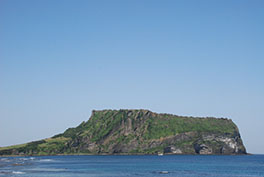 Seongsan Ilchulbong
Seongsan Ilchulbong
Seongsan Ilchul-bong, located at 48Km east of the Jeju city, it is the island's largest volcanic rock cone, which was formed earlier than the Jeju island created. It is a typical hydromagmatic volcano created between 120,000 and 50,000 years ago by an underwater eruption from a shallow seabed. It took its shape by the interaction of hot water and cold seawater. It was originally a small island off the coast of Jeju island, but was later connected with the main island by the action of winds and waves. The crater, 570 meters in diameter and 90 meters deep, has steep slopes. The tuff cone has an impressive appearance reminiscent of a castle or a colossal crown, and its bowl-shaped crater has preserved its original form intact. The crater’s three sides except for the northwestern portion have been eroded by waves and reveal the inner layers of the volcano, serving as an important resource for geological studies on ancient volcanic activities. The volcanic cone has a plateau-like basin surrounded by 99 sharp-edged rocks on its rim. Unlike Mt. Halla there is no crater lake, because of the porous quality of the volcanic rock. This is the place to catch the sunrise, which is the most spectacular in Jeju. Rising from the double-headed peninsula at the eastern end of the island, this volcanic crater rises 182m straight up from the water. Its southeastern and northern outer walls are craggy cliffs which have been eroded by sea water. Only the northwestern side of the peak has a grassy ridge, and this leads to Seongsanpo. The whole crater, with its basalt pinnacles which looks like a crown from a distance, reflects marvelous scenery. As the name Ilchulbong (Sunrise Peak) implies, sunrise viewed from here is a truly magnificent sight.
Royal Tombs of the Joseon Dynasty
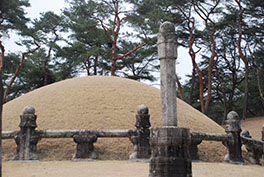 There is a total of 119 royal tombs of Joseon dynasty among which Neung (Reung) are 42, Won are 13 and Myo are 64. Each tomb is designated depending on the royal status. Of these, 42 are royal tombs for Joseon Dynasty kings and their consorts. 39 of them are located near Seoul except Jangneung, the tomb of King Danjong and there are a further 2 located in North Korea. The tombs were built to honor the memory of ancestors, to show respect for their achievements, to assert royal authority, to protect ancestral spirits from evil and to provide protection from vandalism. A royal tomb was a sacred place where the deceased could 'live' in the afterlife amidst dynasty-protecting ancestral spirits. There are three keys to understanding the royal tombs: the topography of the site and the layout of the tomb; the types of burial mounds, the sites' associated structures and the nature and aesthetic qualities of site-specific stone objects; and the rites associated with the burials as well as extant documents that verify the construction process. During the Joseon Dynasty, sites were chosen according to Pungsu (Fengsui in Chinese) principles. Accordingly, outstanding natural sites were chosen, which were mainly along two mountain chains stretching to the north and south of the Han River that flows through present-day Seoul. The burial mounds, the 'heart' of a royal burial ground, were usually placed in the middle of a hillside. Protected from the back, they face outward (to the south) toward water and, ideally, toward layers of mountain ridges in the far distance.
There is a total of 119 royal tombs of Joseon dynasty among which Neung (Reung) are 42, Won are 13 and Myo are 64. Each tomb is designated depending on the royal status. Of these, 42 are royal tombs for Joseon Dynasty kings and their consorts. 39 of them are located near Seoul except Jangneung, the tomb of King Danjong and there are a further 2 located in North Korea. The tombs were built to honor the memory of ancestors, to show respect for their achievements, to assert royal authority, to protect ancestral spirits from evil and to provide protection from vandalism. A royal tomb was a sacred place where the deceased could 'live' in the afterlife amidst dynasty-protecting ancestral spirits. There are three keys to understanding the royal tombs: the topography of the site and the layout of the tomb; the types of burial mounds, the sites' associated structures and the nature and aesthetic qualities of site-specific stone objects; and the rites associated with the burials as well as extant documents that verify the construction process. During the Joseon Dynasty, sites were chosen according to Pungsu (Fengsui in Chinese) principles. Accordingly, outstanding natural sites were chosen, which were mainly along two mountain chains stretching to the north and south of the Han River that flows through present-day Seoul. The burial mounds, the 'heart' of a royal burial ground, were usually placed in the middle of a hillside. Protected from the back, they face outward (to the south) toward water and, ideally, toward layers of mountain ridges in the far distance.
Historic Villages of Korea Hahoe and Yangdong
Hahoe
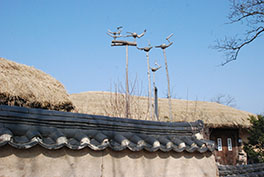 As is set on the knob of land that causes the river to form a S-shape loop meaning Hahoe, the village is named as such. The Nakdong river flows around this village in a S shape with a wide flat silted river valley on both sides. Overhead rears the strange rock cliffs. The village itself contains various typical Korean houses preserved since the early Joseon dynasty, which makes it one of the best traditional villages for the firsthand experience of old tradition. The village, established by the Pungsan Ryu clan in the 15th century, was the home of noblemen. Some 460 Korean traditional houses, both large and small, are well preserved because of its location and of its cultural value. The village is more popular with mask carving and its mask play so called Polshin-gut, the shamanistic ritual dated from the Goryeo dynasty (918-1392). Today, about 300 residents are living here in traditional houses. Queen Elizabeth II came to visit this village on April 21, 1999.
As is set on the knob of land that causes the river to form a S-shape loop meaning Hahoe, the village is named as such. The Nakdong river flows around this village in a S shape with a wide flat silted river valley on both sides. Overhead rears the strange rock cliffs. The village itself contains various typical Korean houses preserved since the early Joseon dynasty, which makes it one of the best traditional villages for the firsthand experience of old tradition. The village, established by the Pungsan Ryu clan in the 15th century, was the home of noblemen. Some 460 Korean traditional houses, both large and small, are well preserved because of its location and of its cultural value. The village is more popular with mask carving and its mask play so called Polshin-gut, the shamanistic ritual dated from the Goryeo dynasty (918-1392). Today, about 300 residents are living here in traditional houses. Queen Elizabeth II came to visit this village on April 21, 1999.
Yangdong
Yangdongmaeul is a traditional village embracing a simple and unadorned natural beauty. It is a relatively less known village which used to be a middle upper-class town during the Joseon dynasty. Just north of the village stands the guardian mountain Solchangsan which breaks into four branches as it descends from the Mujangbong peak. At the entrance to the village, the view is interrupted by steep ridges, making it impossible to guess its grand scale from outside of the valley. Most of the grand old houses can only be seen up close. There were more than 600 houses here, but with the influx of modernization and change of lifestyle, the traditional houses decreased. The houses, built according to the harmonious theory of yin and yang have been handed down from generation to generation in their original elegant forms. Most of the people here are the descendent of Son and Yi family. Most of the houses are still occupied by villagers but some are empty, making it more comfortable to examine them.
Of the significant buildings of the village is Gwangajeong pavilion. It was built by Son Jungdon (1463-1529) whose pen name is Ujae. He served the government as minister of home affairs during the reign of Seongjong. The house has a square layout with inner court, Gwangjeong. The women's quarters appears to be a simple structure with square pillars. At the back of the house is shrine with a gabled roof, and round pillars, and a wooden-floored veranda with a railing. Since the pavilion is located on the high ground level at the entry of the village, it has a wonderful view of the natural surrounds. In the front are two giant gingko trees, which is said to have planted in memory of the pavilion being built.
Hyangdan is a beautiful tile-roofed house complex. It was built in 1543 at the order of King Jungjong as a home for the ailing mother of Yi Eonjeok (1491-1553), who had just been appointed to the governor of Gyeongsang province. Originally, here stood a 99-roomed house, which was later destroyed. The number of rooms was reduced to 56 when the building was reconstructed in 1976.
Mucheomdang is the home of Yi Eonjeok's father, Yi Beom. Built in 1460, it shows simple but elegant workmanship with special highlight on functionality. The signboard bearing calligraphy on the right was written by the Regent of King Gojong, The sign says 'Left sea refined and scholarly'', a reference to the scenery and scholarly associated with the nearby sea.
Simsujeong
pavilion was built in 1560 in memory of Yi Eongwal, whose pen name is Nongjae. Refusing to accept any official position, he is said to have devoted himself to caring of his old mother on behalf of his elder brother, Eonjeok. It is the largest pavilion in the village. Another attractive house is Seobaekdang. It has all the scale and formality of a mansion. Built in the 1454, it is the home of the Son family, the founder of this village. A giant juniper tree of some 500 years old stands graciously boasting fully of its dignity. A geomancer, Seol Changson who selected this place as the best site for a home, predicted that three great figures would come from this house in which the spirits of Mt. Seochangsan are condensed. The first was Son Jungdon (1463-1529), who became a famous government official of impeccable integrity. The second was a famous Confucian scholar Yi Eonjeok, who was born here in his mother's maiden home. The 3rd great figure has yet to appear. A walk through Yangdong can help you to imagine the life of a nobleman during the Joseon dynasty.
Namhansanseong
History shows that Korea has survived almost 900 invasions. The fortresses were built to guard the people against external invasions.
Namhansanseong is the 11.76-km fortress located on a rough mountain ridge immediately to the southeast of Seoul. It served as a strategic stronghold from the Unified Silla era to the Joseon era, reflecting architectural styles from different times. It is a rare example of fortress heritage as no other wall in the world was built on a steep mountain ridge and designed to serve as a temporary capital during war. It has been designated as a UNESCO World Heritage site, at the 38th meeting of the UNESCO's World Heritage Committee in Doha, Qatar, on June 22, 2014, for its outstanding example of architectural and technological ensemble.
It was here that during the Manchu invasion (1636-1637) King Injo took refuge for 47 days until his surrender to China’s Qing Dynasty. Here they were well defended by the protection of a bodyguard of 13,800 soldiers and 3,000 worrier monks. The Manchus were not able to take the fortress by storm, but after 45 days of siege food supply inside ran out, and the king was forced to surrender, giving his sons as hostages and shifting allegiance from the Ming. The Samjeondo Monument was erected on the southern route from Seoul to Namhansanseong to mark this event.
The fortress area once accommodated nine temples, as well as various command posts and watch towers. Today a single command post, Seojangdae, and a single temple, Changgyeongsa, remain. Some of the most unique features lay on its temporary palace, royal ancestral shrine, and altar for the land and grain god, state guardian deities.
Baekje Historic Areas
The eight archaeological sites and ancient historic areas representing the later period of the Baekje, one of the three earliest kingdoms on the Korean Peninsula, were collectively named as a UNESCO World Heritage site, which were built over the different periods of Baekje, spanning nearly 700 years from B.C. 18 to A.D. 660. Included in the list are scattered in three cities, Gongsanseong Fortress and the group royal tombs in Songsanri in Gongju, the Gwanbuk-ri historic site with its Busosanseong Fortress, the Jeonglimsa Temple site, tombs of Neungsan-ri, and Naseong Fortress in Buyeo, Wanggung-ri royal palace site and the Mireuksa Temple site in Iksan. The Gongju and Buyeo areas were the ancient capitals of the late periods of the Baekje Kingdom, who had extensive cultural exchanges with China and Japan. The sites provide a comprehensive view of the history and culture of the Baekje.
Sansa, Buddhist Mountain Monasteries
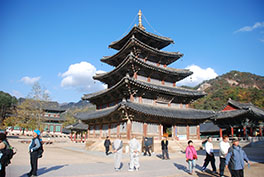 Seven Korean mountain temples, which typify the way Buddhism has merged with indigenous beliefs and styles, were listed as UNESCO World Heritage sites.
Seven Korean mountain temples, which typify the way Buddhism has merged with indigenous beliefs and styles, were listed as UNESCO World Heritage sites.
Seonamsa
Seonamsa, nestled snugly inside a scenic valley at the eastern slope of Mt. Jeogyesan in Seungju, is one of the head monasteries of the Taego Order that allows ordained priests to marry, although nuns must remain celibate. Legend has it that the missionary monk, Ado, built a hermitage named Biroam Hermitage in 529. In total, Seonamsa Temple houses 19 cultural properties in its halls and museum.
A walk along the mountain path, up through the valley, reaches collections of ancient stupas and the
rainbow arced Seungseongyo Bridge at its base a dragon chasing away evil spirits. The temple was largely destroyed in the late 1500s by the Japanese invasion, but was restored in the 1600s after the war.
On the main temple courtyard stands two three-storied stone pagodas from the 9th century that are simplistic in design. The main worship hall Daeung-jeon is extremely plain all but for the Dancheong paint patterns. Housed inside the main hall is a solitary seated statue of Syakamuni Buddha backed by a vibrant painting on the main altar.
Beopjusa
Located on Songnisan east of Daejeon, Beopjusa, The Dharma Staying temple, according to the temple records, was founded in 553 by priest Uisin. Songni means escape from the vulgar, and is the ideal spot to those wishing to escape from the drag of close urbanization. In the 12th century it is noted that the king gathered over 3,000 priests together to pray for the ailing national priest Uichon. The large iron pot of 2.7 meters in diameter on display at the temple may well have been used to feed this large gathering. There are three national treasures and numerous other cultural assets. The five-storied Palsangjon which was reconstructed in 1624, is a rare architectural structure of Buddhism. A caved lantern supported by twin stone lions standing face to face is a rare example of the magnificent sculpturing of the Unified Silla period. A stone water cistern shaped like an open lotus flower is considered unique for beauty and design. On the ground stands a huge statue of Maitreya Buddha. It is a 33 meters high Buddha made of 160 tons of copper. An excellent stone carved relief image called a Maebul can be seen near the entrance to the temple. Hiking trails are available leading to numerous hermitages and eventually the peak of Songnisan. About 2Km before the entrance to Beopjusa temple is a 600 year old pine tree near the road. The legend says that the branch of the tree cleared the passage so as for king Sejo to pass on his palanquin. Sejo became a king by usurping the throne from his 14 year old nephew, king Danjong. In old age, he suffered from a severe skin ailment and tried to find solace in the forest of Songnisan Mountain. One day he met a young woman here whose two boys called him grandfather. The woman was princess Uisuk, Sejo's daughter, who had to flee from her father because she had pleaded for the life of the murdered nephew. At this meeting, the king begged for forgiveness and invited his family back to the palace. The princess refused, saying that she preferred her simple life, and she later fled further south.
Magoksa
Magoksa (Flax Valley Temple) is quietly nestled about 15km west of Gongju. Built in 640, Magoksa is a truly traditional temple in the deep mountains virtually untouched by modern civilization. The clean clear scenic beauty and water is refreshing, while the varied rock patterns, formations and coloration in the vicinity will make the visit unforgettable. Quiet meditative atmosphere still remains along with mountain charm, lulled by the musical rhythm of stream water flowing through the temple grounds and wind rustling through the dense woods. Near the entrance of the temple is a side compound of buildings of which the Yeongsanjeon is the main structure. The main entrance to Magoksa is quite traditional for typical Korean Buddhist temple. The initial gate is the Haetalmun where two large guardian deities are found positioned on either side. The next gate is Cheonwangmun housing four temple guardians. Daegwangbojeon is a main worship hall. The architectural style is the one that uses the multi clustered brackets which is characterized by the luxurious and grandiose outward appearance. Enshrined inside the hall is Virocana Buddha, which is the Body of True Buddha. Behind this building on a hill is Daeungbojeon housing Sakyamuni Buddha attended on each side by Amitabha and Buddha of Medicine. In the center of the temple courtyard stands a 5-storied pagoda of Yuan influence, by Lama of Yuan, the ancient Chinese kingdom. The pagoda lacks s sense of stability because its capstone has almost the same breadth. Four Buddhas are carved on the surface of the body stone. The edges of the pagoda are decorated with a bronze miniature.
Tongdosa
Before entering the temple compound, the visitor has to pass over the windless bridge which leads into a forest of pines. Most temples have a bridge, often over a wonderful rushing torrent, before the gates to the compound. This is a symbolic purification of the individual as he or she passes form the secular world into the spiritual world. It was built in 646 by one of the most famous monk Jajang (608-686) on his return from China. The temple was destroyed by Hideyoshi invasion and the main hall of the temple was reconstructed in 1645. There are 35 buildings and small hermitages in the valleys behind the temple. It is unique in that it has no statue of the Buddha, only a window looking out onto a stupa. Unlike other Buddhist sanctums, the ceiling of the main hall is especially marvelous as it is covered with a beautifully executed pattern of chrysanthemums, and has a hip-and-garble roof. This style of this building is known as that of multi-cluster bracketing. The main worship hall has no paintings or Buddha images: You look out a window to the stupa that contains the Buddha's relics. And it is here next to the Vajra or Diamond Platform that the Jogye Order, Korea's celibate sect, traditionally holds its ordinations. Thus, one "passes through" here on the road to enlightenment. The altar has a two-story structure engraved with Buddha and eight gods protecting the laws on the lower portion, while flying deities are on the upper portion.
The Diamond Precept Altar is a unique and elaborately-built artifact. It is believed to enshrine the Buddha's remains which master Jajang brought from China and is therefore the focal point of the temple. The name Vinaya for the Tongdosa precepts altar comes from the diamond treasure precepts, the Mahayana rules a presented in the Sutra of Brahma's net. The diamond reference signifies indestructibility, i.e. once received, the rules are never lost. The name also suggests the primacy of discipline among the three Buddhist vehicles of learning in the quest for attaining enlightenment. The three
studies are (a) learning by the commandments, or prohibitions, (b) learning by quiet meditation and (c) learning by wisdom or philosophical principles. Normally, the precepts altar, which enshrines Buddha relics, is located in front of the Buddha halls, however, there is no Buddha statue inside the Buddha hall, which instead has a window looking out to the stupa behind it. Of special interests are the museum which contains many precious ancient objects, the memorial shrine to Jajang built in 1727, and the Great Hall of Light. this last is a hall dedicated to Virocana Buddha and was constructed 600 years ago. Of note is the lovely Nine Dragon Pond. Originally it was very large and nine dragons lived in it. However, after some time it was reduced in size and now the monks who live in the temple believe there is only one resident dragon which never comes out.
Bongjeongsa
Founded in 672 AD by Buddhist priest Neungin (Some record say by Euisang), the temple literally means "the Temple of Phoenix Landing ". The temple holds a following legend on its foundation. A young Neungin, Euisang's disciple, was in deep meditation in the dark rocky cave near the summit of the Cheondung Mountain. One day, a heavenly maiden appeared in front of him meditating, and tempted him. But her attempt was failed after all. Much impressed, she lighted cave by offering heavenly light. After that, Neungin acquired more miraculous power and flew paper phoenix from his cave. He later built a temple on which the phoenix landed, and the temple was named as such. There are 10 buildings in this temple. Daeungjeon, a central building of Bongjeongsa, is particularly apparent in the multi-cluster bracketing of the eaves which is characterized by simplicity and sturdiness. Geukrakjeon, the Korea's one of the oldest wooden edifices, three storied ancient stone pagoda, the main sanctuary of the temple, Hwaeom lecture hall, Yeongsanam hermitage, belfry, and Deokhwiru pavilion are among the temple attractions. Queen Elizabeth II came to visit this temple on April 21, 1999. About 20 minute walk from the temple is the 7th century Gaemoksa, meaning 'the Temple of Opening Eyes '. According to the legend, a heavenly maiden appeared to help Uisang, who was in meditation, attaining enlightenment. Thus this temple is said to have been built on that site. In Andong, there were extremely large numbers of blind people. Since then, there were no blind men in Andong and its neighboring towns. Today, there is a small hermitage which was built in 1457. Not far from here is a cave where Neungin meditated.
Buseoksa
Buseoksa, temple on the floating stone, was built by priest Uisang in 676. The temple stands at the eastern slopes of Sobaeksan national park in the north of Yeongju. The Main Hall enshrines Amitabha. Originally built in 676, the present structure dates to 1376 and is one of the oldest wooden buildings in Korea. The foundation is of granite. The columns supporting the roof are fitted with brackets which are actually amazingly simple. The hipped-and-gabled roof is in perfect proportion to the body of the building, giving the hall a unique feeling. The Amitabha, Buddha of the Western Paradise or Buddha of Infinite Life,
is enshrined on the western altar inside the Main Hall. Buddha is made of clay and 278Cm in height behind of which round halo measures 380Cm in height. It is seated with the cross-legged lotus posture and with the earth-touching and evil-expelling hand gesture. The statue has a large usnia (a protuberance on top of the head symbolizing supreme wisdom), a well-rounded face, two long ears and three folds on the neck. To the left of the Main Hall, at the bottom of a steep bluff, lies the legendary floating stone. To the right of the stone is a three-story pagoda behind which is a pavilion dedicated to the Chinese girl who, in the form of a dragon, helped Master Uisang. In the front of the Main Hall stands the 9th century stone lantern, which is known as one of the most beautiful lanterns made during Unified Silla period. The octagonal base of the pedestal is decorated with inverted lotus petals and flowers. Above it, the rectangular pedestal, which serves as the base of the light chamber, is decorated with upturned lotus petals. The Bodhisattvas carved in relief on the four sides of the light chamber are considered superb examples of sculptural work. Josadang, a hall for portraits of great masters, lies 100 meters to the northeast of the Main Hall. The building's original frescoes of guardians and gods are the best existing examples of Goryeo Dynasty wall paintings and are currently being kept in a separate place for safe-keeping. Buseoksa has many treasures: the flagpole supports; the Goryeo wood-blocks; the Budo, conical stone object in which the remains of famous monks are kept; the two stone pagodas; and the monument to Priest Wonyung, are only some of the wonderful objects which have survived Korea's turbulent history.
Daeheungsa
Daeheungsa
is located on the junction of two peaks, Noseungbong and Garyunbong in Haenam. It is the head temple of the 22nd parish of the Jogye Order. No exact record of its founding has survived, but remains as the center of Buddhist worship. Although the pressure was high during Joseon period, Daeheungsa has managed to produce many famous monks. After one pillared gate followed by another gate to pass, Haetalmun of four deva kings common to most temples. But enshrined inside are Manjusri on a blue tiger and Samantabhadra on a white elephant for the temple is surrounded by 4 guardian mountains, Cheongwansan, Seoneunsan, Dalmasan, and Wolchulsan in four directions. The temple is unique and rare with its mixture of Buddhism and Confucianism influence. One such example is Pyochungsa shrine inside which enshrines the portraits of three great priests Seosan, Samheongdang and Noemukdang, all of whom recruited worrier monks and fought against the Hideyoshi troops. This shrine is erected in 1788 here to extol and revere the patriotic deeds of great masters. The wooded path to the temple is tranquil and refreshing, dusting off your mind and to be free from idle thoughts. At the entrance, you could hardly miss stupas that hold the relics of great masters including Seosan. He once stated that Daeheungsa would never suffer from disaster caused by Wind, Water or Fire. You sure to check out the mountain ridge in distance that resembles a lying Buddha. There are number of bridges to cross and when you enter the temple, you start winding down. The main worship hall called Daeungjeon has a hipped and garbled roof and enshrines Triad Buddha with Sakyamuni Buddha in the middle attended on each side by Amitabha (Buddha of Infinite Life) and Bhaisajyaraja (Buddha of Healing). On the left side of the main hall is Eungjinjeon hall that enshrines Sakyamuni attended by two bodhisattvas; Manjusri and Samantabhadra. The tree story pagoda standing in front of Eungjinjeon hall dates to Silla period. Cheonbuljeon is a hall that holds one thousand Buddha statues made out of a jade some 250 years ago in Gyeongju. Nearby is a museum exhibiting many relics of Seosan, such as the portrait, shoes, praying beads, his own calligraphic works, robe, and bowls. There are many other halls common to most temples. Of the significant cultural assets includes bronze bell, Buddhist paintings, rock carved relief Meitreya Buddha and three story pagoda which can be reached by quite a trek.
Seowon, Korean Neo-Confucian Academies
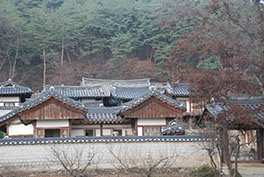 Seowon or neo-Confucian academy refers to private education institutions of the Joseon Dynasty (1392-1910), and was a birthplace of Confucian education and a cradle of prominent scholars. The traditional role of Seowon was to cultivate well-trained Sarim, the literati class who focused on academic learning and the development of moral discipline. It also served as a shrine for honoring venerable individuals.
Seowon or neo-Confucian academy refers to private education institutions of the Joseon Dynasty (1392-1910), and was a birthplace of Confucian education and a cradle of prominent scholars. The traditional role of Seowon was to cultivate well-trained Sarim, the literati class who focused on academic learning and the development of moral discipline. It also served as a shrine for honoring venerable individuals.
Sosu Seowon (1543)
It is the first private institute established in Korea, and was a birthplace of Confucian education and a cradle of prominent scholars. About 4,000 scholars, including the pupils of Confucian scholar Toegye Yi Hwang, studied at the institute.
As the first Confucian school financially supported by the king, it was established by Ju Se-bung in 1543 and named Baekundong Seowon.
The compound itself is composed of two sections; academic studies and research, and memorial service. There are several old buildings where scholars learned and studied loyalty, filial piety, manners and knowledge.
Surrounded by a tranquil and natural environment, the school has various traditional halls in which students resided for their studies.
Ganghakdang, the study place, features unique architectural styles such as a four-sided wooden verandah and entasis columns.
The institute has a shrine, which was built to enshrine An Yang, An Bo, An Chuk and Je Se-bung, where a memorial service takes place twice a year on the first day of the third and ninth months by the lunar calendar. There were hundreds of Seowon by the early 1800s, but most Seowon were closed by an edict of the regent Daewongun in the turbulent final years of the 19th century. Daewongun was driven from power in 1873;and this Seowon was survived. Visitors can see the moral values and ethics based on Confucianism, which is manifested even through the construction arrangements.
Namgyeseowon (1552)
Namgye Seowon, honoring Jeong Yeochang (1450-1504),
was the first in Korea to follow the prototypical design of the Korean seowon, with the learning space in the front and shrine at the rear—the highest spot in the seowon. The layout of Namgyeseowon was copied by many subsequently built Seowon. The main gate Pungyeongnu welcoems visitors. There is a framed inscription that reads: “The view is open on all sides. There is a wide field and stream that flows around the area. The forest, which is far off, is verdant. The sunset in the evening is beautiful.”
Behind the gate stands the student dormitories, Yangjeongjae and Boinjae, and two pavilions, Aeryeonheon and Yeongmaeheon. Two little ponds, which bears the fragrance of lotus flowers and cherry blossoms, is positioned close to the learning space to provide a small resting place—an arrangement rarely seen in seowon construction. Behind this is Myeongseongdang, which has two name boards that each bear half of the seowon’s name (“Namgye” and “Seowon”) in Chinese characters. Gyeongpangak, a structure made entirely out of wooden planks, stores the books and woodblocks. There is a steep stairway at the top of which is the shrine. Namgyeseowon was the first to position its shrine physically much higher above the learning space as a show of respect for those enshrined in it.
Oksanseowon (1572)
This Seowon was founded in 1572 by sarim of Gyeongju who wanted to honor the learning and loyal spirit of Yi Eon-jeok (1491-1553).
Facing west, Oksanseowon is surrounded by mountains on three sides, and clear stream in the south,. One notable feature is a large rock, called “Sesimdae,” which Yi Hwang described as a place where “one can wash away the impurities of the heart with clean water and focus on study with nature in the background.”
The learning halls, Mubyeonnu, and Guindang, in which the student dormitories Dongjae and Seojae face each other. Guindang features the writing of noted individuals: the name board under the eaves that reads “Oksanseowon” was written by Kim Jeong-hui. Another Oksanseowon name board hanging at the daecheongmaru and inscribed with “Oksanseowon” was written by Lee San-hae who was known for his calligraphy. The “Guidang” and “Mubyeonru” name boards in the inner corner of the daecheongmaru were written by Han Seokbong.
About 700 meters along Jagyecheon Stream in a northwesterly direction is Dokrakdang, where Yi spent his days reading books alone while surrounded by nature. Surrounded by a clay wall with a closable door, Dokrakdang has a small window in the rear wall that looks over a stream, which offers a pleasant experience for both the eyes and ears. It is a good example of Chagyeong literally means ‘appropriative landscape’ or ‘borrowed scenery’, refers to a design method which uses or appropriates distant scenery as a part of my own landscape by positioning the building and windows for the view.
Dosan Seowon (1574)
It is located about 30km north of Andong, bordered by Andong lake in its front and dense pine forests to the rear creating lyric scenery.
Yi Hwang (1501-1570), a Confucian scholar, built Dosan Seodang to educate the disciplines and study himself after he left the officialdom in 1549. In 1574, Dosan Seowon was built in memory of Confucian scholar Yi Hwang by some of his disciples and Confucian authorities. Later, it became the center of the Confucianism in the region when it was granted the status of court-sponsored shrine-academy in 1575.
The academy is composed of 16 buildings most of which were built in a simple and concise style. Some of the notable buildings are Dosan Seodang, Gwangmyeongsil holding 5,000 volumes of books including selected books of Yi Hwang, Nongunjeonsa, Jangpangak and a shrine. The library of the Seowon contains a total of 4,338 volumes of 907 types of old books and woodblock prints on Neo-Confucianism. Sisadan, which is surrounded by pine trees across the river from the seowon, is where a special civil service exam was held in 1792 by decree of King Jeongjo to commemorate the academic accomplishments of Yi Hwang and give local residents the opportunity to enter public service. As the story goes, so many exam takers gathered on that day that the exam could not be held at Dosanseowon but was instead held further down the river!
The Seowon serves two purposes; education and commemoration. Although the educational function of the facility has long since ceased, the commemorative ceremonies have been and are still held twice a year.
Piramseowon (1590)
It was established in 1590 by local Neo-Confucian scholars to commemorate the academic learning of Kim Inhu (1510 – 1560). The word Piram literally means “brush rock,” and was moved to its current location in 1672. Starting with Hwakyeonru, which is a resting place, Cheongjeoldang, where classes are held is located behind it. Dongjae and Seojae, which are the living spaces for students, are located behind it. A separate space with a gate and a wall in the back was a shrine to hold ancestral rites.
Piramseowon was a key station of Sarim resistance to Japanese forces during the Hideyoshi Invasion in the late 16th century. The Seowon houses documents such as directors of the Seowon, those in charge of education, and a list of students, providing valuable data for researching the Seowon's operation and exclusive education system. One particular hall in this Seowon is Gyeongjanggak whose name board was written by King Jeongjo. At the age of 34, Kim Inhu served as the teacher of the crown prince, who would later become King Injong. The crown prince was impressed with his learning and integrity and is said to have created for his teacher a bamboo painting. This painting was kept at Gyeongjanggak for many years, after which it was donated by the descendants of Kim Inhu to the Gwangju National Museum.
Dodongseowon (1604)
Dodongseowon, whose name means “the Truth has come to the East,” was built to commemorate the academic learning and moral fortitude of Kim Goengpil (1454-1504), who was a Neo-Confucian scholar of the early Joseon Dynasty. Laid out in the typical Seown style, it has a shrine for Confucian sages at the back of a lecture hall. The entire compound including the lecture hall, shrine, and surrounding walls are collectively designated as Treasure and a historic site for its more effective preservation and management.
Byeongsanseowon (1613)
About 6km away from the Hahoe village, standing opposite a rock cliff encircled by the Nakdong River, is Byeongsan Seowon.
It was built on the site where Ryu Seongryong (1542-1607) trained his disciples.
In 1614, Confucians erected a memorial tablet for him to commemorate his scholastic achievements and knowledge, thereby making this a famous academy.
Byeongsan Seowon houses over 1,000 documents and 3,000 books.
The Seowon boasts its beautiful scenery and excellent architecture. In particular, the natural scenery from Mandaeru pavilion is superb. Ipcyodang, an auditorium where students received education, offers a harmonized view of nature and architecture.
Museongseowon (1615)
Museongseowon originated from the construction of a shrine to commemorate Choi Chiwon (857-908), who made great achievements while serving as Taesan governor. Museongseowon is highly regarded as a center of academic culture that educated the people through propriety. Unlike other Seowons, it is located within a village, so residents can democratically participate to control the Seowon operation. Additionally, it has a unique architectural layout. A typical Seowon had two dormitories centered around the lecture hall. Gangsujae, where Confucian scholars reside, and Gojiksa, the Seowon office, are separated from the core part of the Seowon. Due to this arrangement, there is a view that Museongseowon is more symbolic as an ancestral rite space than as an educational space.
Donamseowon (1634)
It was established to commemorate Kim Jangsaeng (1548-1631), a prominent Confucian scholar. The 16th and 17th centuries were a difficult time for Joseon: it was a period full of purges, revolts, and several wars with Japan. With Neo-Confucian theory unable to take sole responsibility for rebuilding society and serve as the moral compass of citizens, the study of propriety was adopted as an alternative. Kim’s political and social views, which were based on propriety, were established at a time in Joseon history when they were needed most.
Donamseowon (1634)
It was founded to commemorate Kim Jangsaeng (1548-1631), a prominent Confucian scholar, for his learning and virtue. The 16th and 17th centuries were a difficult time for Joseon: it was a period full of purges, revolts, and several wars with Japan. With Neo-Confucian theory unable to take sole responsibility for rebuilding society and serve as the moral compass of citizens, the study of propriety was adopted as an alternative. His political and social views, which were based on propriety, were established at a time when they were needed most.
The tidal flsts
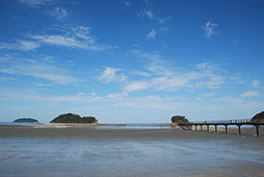 The tidal flats of Korea comprises four component parts: Seocheon Getbol, Gochang Getbol, Shinan Getbol and Boseong-Suncheon Getbol. The site exhibits a complex combination of geological, oceanographic and climatologic conditions that have led to the development of coastal diverse sedimentary systems. Each component represents one of four tidal flat subtypes (estuarine type, open embayed type, archipelago type and semi-enclosed type).
The tidal flats of Korea comprises four component parts: Seocheon Getbol, Gochang Getbol, Shinan Getbol and Boseong-Suncheon Getbol. The site exhibits a complex combination of geological, oceanographic and climatologic conditions that have led to the development of coastal diverse sedimentary systems. Each component represents one of four tidal flat subtypes (estuarine type, open embayed type, archipelago type and semi-enclosed type).
The shallow waters in the Yellow Sea region hold some of the largest and most spectacular intertidal wetlands in the world. These sites support exceptionally rich biodiversity, but are best known for some of the largest congregations of migratory waterbirds in eastern Asia, many of which are globally threatened by habitat loss along their migratory pathways, collectively known as the East Asian ? Australasian Flyway. Up to 100,000 shorebirds use the mudflats around Yubu island in the Seocheon Getbol during migration, including the Critically Endangered Spoon-billed Sandpiper and the Endangered Far Eastern Curlew. Other species, such as Vulnerable Saunders’s Gull and Endangered Black-faced Spoonbill stay to nest in the coastal wetlands of the Yellow Sea.
Sitting on the north-eastern fringe of the Yellow Sea, straddling the western coast of the Korean Peninsula and China, South Korea’s wetlands form an integral part of this coastal ecosystem.
The sites host high levels of biodiversity, with reports of 2,150 species of flora and fauna, including 22 globally threatened or near-threatened species. It is home to 47 endemic and five endangered marine invertebrate species besides a total of 118 migratory bird species for which the site provides critical habitats. Endemic fauna includes Mud Octopuses (Octopus minor), and deposit feeders like Japanese Mud Crabs (Macrophthalmus japonica), Fiddler Crabs (Uca lactea), and Polychaetes (bristle worms), Stimpson’s Ghost Crabs (Ocypode stimpsoni), Yellow Sea Sand Snails (Umbonium thomasi), , as well as various suspension feeders like clams. The site demonstrates the link between geodiversity and biodiversity, and demonstrates the dependence of cultural diversity and human activity on the natural environment.
Gaya Tumuli
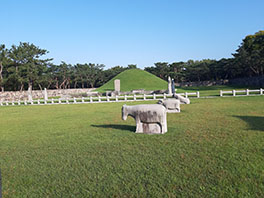 The Gaya Tumuli are the monumental burial places of the leaders of the unique Gaya Kingdom (42-562) that existed independently by binding together component polities with similar cultural characteristics. But they never developed into a true unified state. Enlisted seven tumuli sites are located on highly visible hilly areas in the political centre of their respective polities. They are Gimhae Daeseong-dong Tumuli, Haman Marisan Tumuli, Changnyeong Gyo-dong and Songhyeon-dong Tumuli, Goseong Songhak-dong Tumuli, Hapcheon Okjeon Tumuli, Goryeong Jisan-dong Tumuli, and Namwon Yugok-ri and Durak-ri Tumuli.
The Gaya Tumuli are the monumental burial places of the leaders of the unique Gaya Kingdom (42-562) that existed independently by binding together component polities with similar cultural characteristics. But they never developed into a true unified state. Enlisted seven tumuli sites are located on highly visible hilly areas in the political centre of their respective polities. They are Gimhae Daeseong-dong Tumuli, Haman Marisan Tumuli, Changnyeong Gyo-dong and Songhyeon-dong Tumuli, Goseong Songhak-dong Tumuli, Hapcheon Okjeon Tumuli, Goryeong Jisan-dong Tumuli, and Namwon Yugok-ri and Durak-ri Tumuli.
These tombs are considered to be a ‘time capsule’ that shows the history, nature, culture, and legacy of the long-lost kingdom of Gaya. The production and distribution of iron-made products drove social change and development in ancient societies. The sheer number of iron artifacts discovered in these tombs proves just how important iron was in the Korean peninsula. Gaya was a federation of twelve small kingdoms in the Byeonhan region of Korea. In total, there were six Gaya kingdoms, including Geumwan Gaya in Gimhae and Daegaya in Goryeong. Together, the Gaya kingdoms traded with Nakrang, China, Japan, and other regions of the Korean peninsula thanks to an abundance of iron.
Gaya tombs are a window into the culture, history, and natural environment of Gaya. The Gaya tombs are not only unique evidence of the sophisticated civilization and political system that Gaya managed to build as a federation of small states despite being surrounded by other ancient kingdoms with more consolidated power structures, but also a great example of a rare type of civilization that thrived in ancient East Asia.





